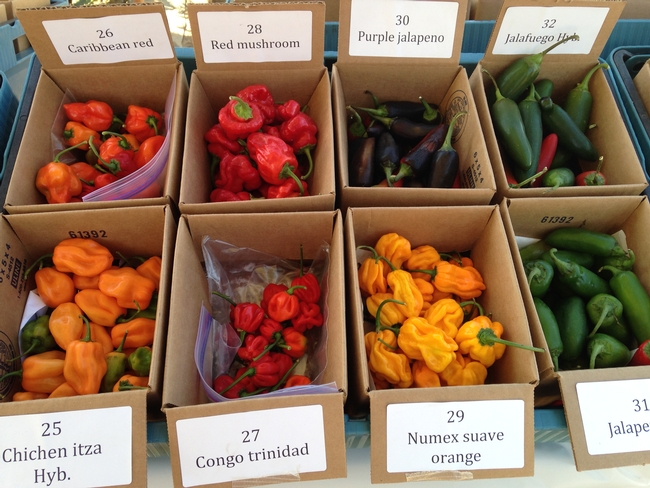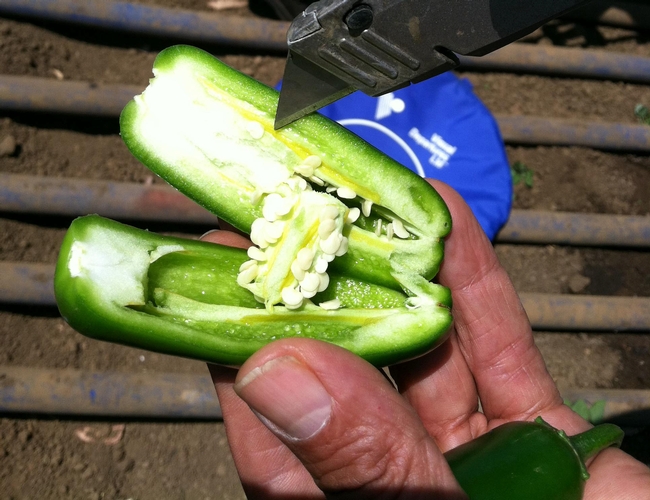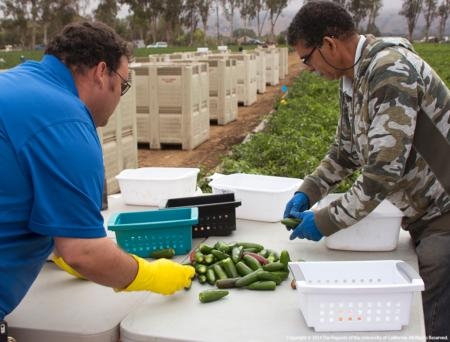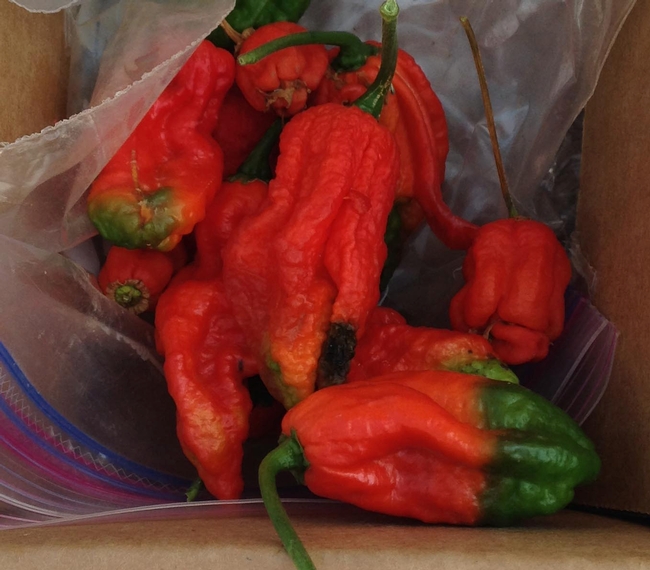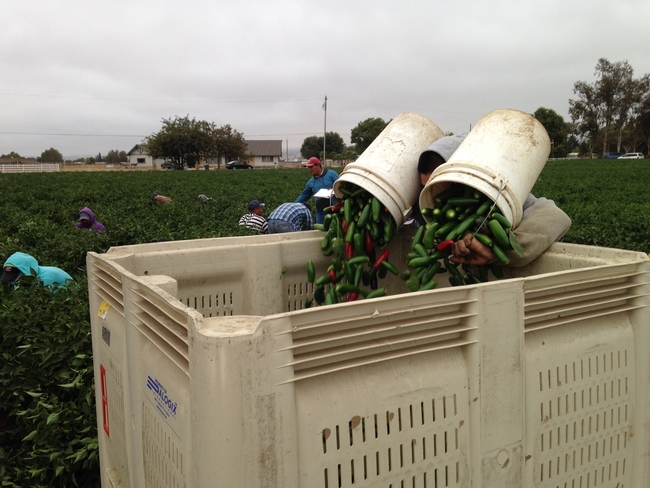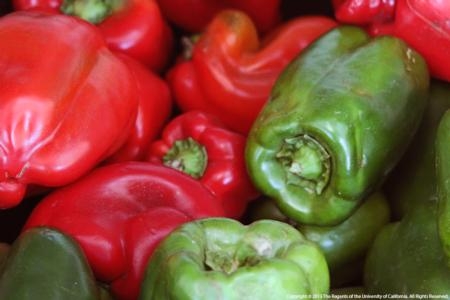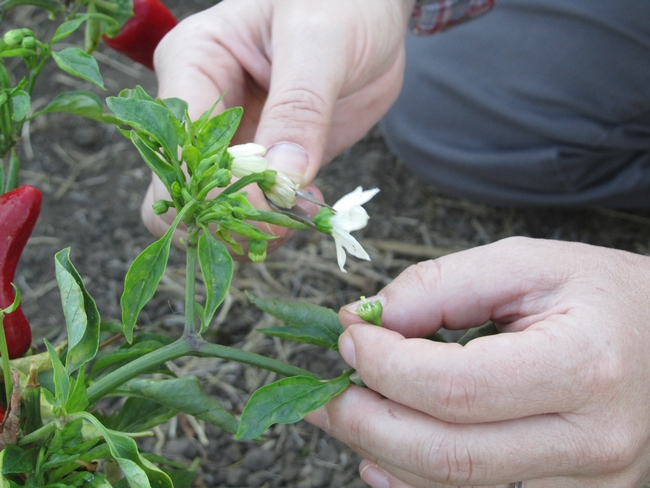Posts Tagged: peppers
Pests make it challenging to grow chile peppers
Ethiopian, Mexican and Thai cuisine all taste distinctly different, but they have something in common: chile peppers. Demand for chile peppers is growing steadily and California is a leading producer of the vegetable that adds spice to life. Cash receipts for California chile peppers increased from $59 million in 2010 to nearly $100 million in 2012, according to USDA statistics. In Santa Clara County, 70 varieties of peppers are grown. Peppers are challenging to grow because they are susceptible to diseases, many of them spread by insects.
“Tomato spotted wilt virus spread by western flower thrips is a big problem for peppers,” said Shimat Joseph, UC Cooperative Extension advisor in Monterey, Santa Cruz and San Benito counties. Tomato spotted wilt can cause a plant to produce discolored fruit that is unmarketable and it can kill the plant. Joseph advises pepper growers on integrated pest management methods to control insects.
“We believe it is critical to manage thrips early in the season because when the plants are small, they are more vulnerable,” Joseph said, “and the disease may not show until later in the season.”
He is currently studying the effects of applying insecticides a month after transplanting to discourage thrips from feeding. He also recommends removing weeds, which can host the virus.
Some like it hotter: UC Cooperative Extension tries to grow a spicier jalapeño
Slicing open a ripe green jalapeño he had just snapped off a plant in the field, Aziz Baameur pointed the blade of his pocket knife at the yellow line. “This is where capsaicin is located. It's what gives the pepper its pungency and it's what we're trying to increase,” said the UC Cooperative Extension advisor.
“Some people think the seeds make it hot, but capsaicin is what makes chile peppers hot,” said Baameur, who works with vegetable growers in Santa Clara and San Benito counties.
Baameur is trying to grow a hotter jalapeño by studying the variables that raise the Scoville units, which measure a pepper's heat. For the past four years, he has been documenting the effects of different rates of water, potassium, sea salt and nitrogen applied to the jalapeño crop at George Chiala Farms in Morgan Hill.
“We're trying to find a way to raise the capsaicin level of the jalapeño and raise the Scoville units, which will then allow us to have spicier peppers,” said Jeff Sanders, raw product coordinator for George Chiala Farms.
Research studies in Mexico, Taiwan, Thailand and Spain have shown that water stress results in hotter peppers so Sanders and Baameur tried irrigating with less water. “For us, it did not show that,” Baameur said. “We sampled fruit and we analyzed it for capsaicin content, which makes a pepper hot. It was fairly low, actually it was almost half of what the normal treatment, or control, would be.”
The relatively cooler climate of the Santa Clara County area may be the reason the pepper plants produce different results. “I think it's more a relation to heat, ambient temperature, much more than just water,” Baameur said. “Cool years and hot years will result in different heat units for the same jalapeño variety.”
The amount of potassium hasn't made a difference, but adjusting nitrogen fertilizer seems promising.
“High nitrogen is promising because it produces a hotter pepper and also allows for high crop yields,” Baameur said. “Low nitrogen also resulted in higher pungency, it brings a lot of heat in the peppers,” he said. “However it is correlated with lower yields.”
Next season, Baameur will try to determine the optimal amount of nitrogen to apply to raise the capsaicin levels of the jalapeño without hurting crop yields.
“The trend lately is toward hotter items,” said Sanders, noting a growing popularity of foods containing habanero and even the Bhut jolokia, or ghost pepper. “Both of those are significantly hotter than jalapeños, but the jalapeno is still sort of the standard bearer for a hot pepper,” Sanders said. “Those are the items people consistently want. A jalapeño chip still has more name recognition than a habanero chip. And the hotter you get the pepper, the easier it is to adjust your end product.”
Although there are hotter peppers, such as habaneros, cayenne and ghost peppers, adding other peppers to the end product would alter the flavor. Bhut jolokias, for example, can be up to 1,000 times hotter than a jalapeño, but have a citrus flavor.
“When you're talking about a small amount of that pepper in your product, just a slight citrus flavor can overpower the heat very easily,” said Sanders. “So it's more important that we reach high heat levels with the flavors that our customers are requiring.”
Consistency of pungency in the peppers is also one of the pepper grower's goals.
“We're trying to get a consistent heat level so that our jalapeños going to the processing plant always reach the same Scoville unit score,” Sanders said. “This makes our end product more consistent, which makes our customers happy because then the product they receive to go into their items is more consistent.”
New cost studies for bell peppers, celery and cabbage production in Ventura County
Four new UC studies have examined costs for producing vegetable crops - fresh bell peppers, processing bell peppers, cabbage and celery - in Ventura County. The cost studies are now available from the University of California Cooperative Extension.
Analysis for the crop is based upon hypothetical farm operations using practices common in Ventura County. Data regarding production practices, inputs and prices were collected from growers, UCCE farm advisors, agricultural institutions, and supply and equipment dealers.
The studies describe the assumptions used to identify current costs for the crop, material inputs, cash and non-cash overhead, and profitability analysis. Ranging analysis table shows profits over a range of prices and yields. Other tables show the monthly cash costs, the costs and returns per acre, hourly equipment costs and the whole farm annual equipment, investment and business overhead costs.
The four new cost studies are:
- Costs and Profitability Analysis for Bell Pepper Production in the Oxnard Plain, Ventura County 2012-13, Bell Pepper Production for Fresh Market, by E. Takele, O. Daugovish, M. Vue
- Costs and Profitability Analysis for Bell Pepper Production in the Oxnard Plain, Ventura County 2012-13, Bell Pepper Production for Processing, by E. Takele, O. Daugovish, M. Vue
- Costs and Profitability Analysis for Cabbage Production in the Oxnard Plain, Ventura County 2012-13, E. Takele, O. Daugovish, M. Vue
- Costs and Profitability Analysis for Celery Production in the Oxnard Plain, Ventura County 2012-13, by E. Takele, O. Daugovish, M. Vue
For more information about the vegetable studies, contact Etaferahu Takele, UCCE area advisor, at ettakele@ucanr.edu or by calling (951) 683-6491 in the UCCE Riverside County office.
These cost studies and cost of production studies for other crops are available online at on the UC Davis Cost Study website, at UC Cooperative Extension offices and by calling (530) 752-3589.
Captivating capsicums: Igniting interest in plant breeding
Peppers in an array of colors, shapes, sizes and flavors grown at the UC Davis Student Farm are igniting interest in plant breeding and the astonishing botanical diversity of the Capsicum genus, to which all peppers belong.
“Fifty-two varieties is a wonderful candyland for me, but it’s just a few of the many varieties in the world,” said graduate student Ildi Carlisle-Cummins, who works on a partnership project between the Student Farm and researcher Allen Van Deynze.
Funded by the U.S. Department of Agriculture, the pepper project is meant to educate students and the general public about the importance of plant diversity and career opportunities in plant breading.
“Peppers make it easy because they leave such a strong impression,” said Carlisle-Cummins, who has been organizing field trips for students from second grade and up. “Students become fascinated with plant diversity and variety, and want to know more about molding and shaping it.”
While Carlisle-Cummins’ personal research is focused on sustainable food systems, she is delighted to explain cross pollination to show students how to develop new varieties of plants.
Plant breeding allows humans to select for certain desired traits, such as flavor, yield and pest resistance.
Agricultural has always been a dynamic, innovative industry, Carlisle-Cummins points out. Peppers originated in South America, in the region around modern day Bolivia. Over the centuries, a few species were taken by explorers all over the world. Farmers developed a kaleidoscopic array of subvarieties to suit their needs. Today, researchers are focused on developing new varieties to address new issues, like climate change.
“The world is changing,” Carlisle-Cummins said. “It’s pretty critical we have crops that can survive new places and climates and continue to feed us. It’s critical that we continue to inspire people to go into these fields of research so we have people who know how to work with plants, so they adapt along with a changing world.”
The chile pepper program continues throughout the year. Contact Ildi Carlisle-Cummins at icarlislecummins@ucdavis.edu to find out about upcoming events.
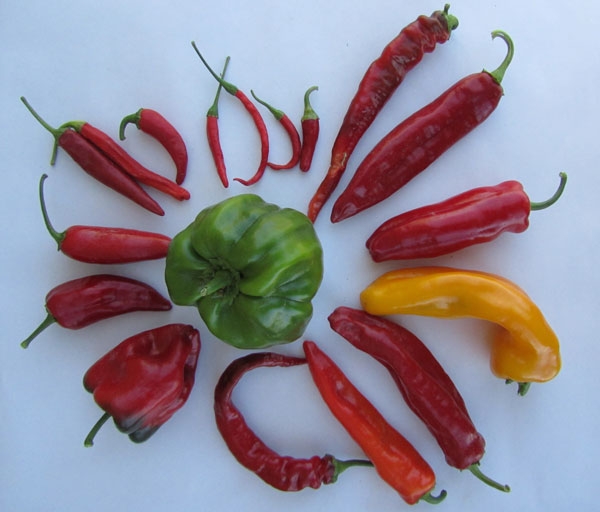
An array of peppers.
Survey identifies 19 produce candidates for a farm-to-WIC program
A new federal voucher that gives low-income women access to a range of fruits and vegetables could provide unique new marketing opportunities for California growers.
In 2009, the federal Special Supplemental Nutrition Program for Women, Infants and Children (WIC) began distributing monthly cash vouchers to low-income women with children to buy fruits and vegetables. The program reaches almost half of the infants and one-quarter of children under 5 years old in the United States.
A team of UC Cooperative Extension (UCCE) researchers and nutrition advisors has been exploring the possibility of developing a farm-to-WIC program that would link these low-income consumers with local growers. The purpose of such a program would be to increase the consumption of a wide variety of fresh produce, with a focus on locally grown produce when available.
UCCE conducted a survey of produce preferences and buying habits among WIC participants in Tulare, Alameda and Riverside counties in 2010. The full study is published in the January-March 2012 issue of California Agriculture journal.
Based on the results, the UCCE team developed a list of 19 produce items to promote in a possible new farm-to-WIC program. They are:
|
|
|
Although mustard greens and collards were not popular across all sites, the advisors gauged a potential market in Alameda County, so these were retained. Based on write-in responses, oranges were also added.
In California, which has the nation's largest WIC program, 82 local agencies serve about 1.43 million participants at 623 local centers, and WIC participants can redeem their monthly vouchers at 4,000 grocery stores statewide. About 40 percent shop at WIC-only stores, which stock and sell only WIC-authorized foods.
Stocking produce is relatively new to WIC-only stores; before rollout of new WIC food packages in October 2009, these stores were only required to stock limited amounts of fresh carrots. In the survey, most WIC participants (58 percent to 72.3 percent) responded that their preferred stores offered many choices, but fewer participants (18.5 percent to 41 percent) rated the produce quality as “excellent.” Key factors determining purchase decisions were produce quality and freshness, and nutrient value (vitamins and minerals). Cost was relatively less important, possibly because WIC participants procure the produce with the vouchers.
The list has served as a starting point for discussions with growers and WIC vendors.
“The survey showed that WIC participants were interested in purchasing fresh produce with better quality and more variety,” wrote lead author Lucia L. Kaiser, Cooperative Extension specialist in the UC Davis Department of Nutrition, and co-authors, in California Agriculture. “Some WIC participants that we surveyed said they avoided shopping at WIC-only stores in part because these interests were not met.”
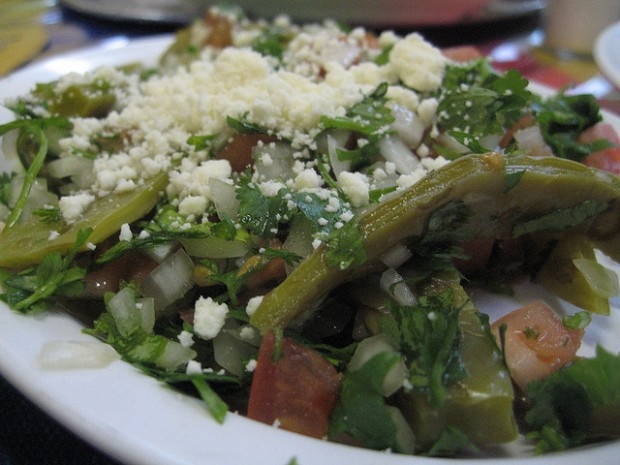
A dish made with nopales (cactus pads).

